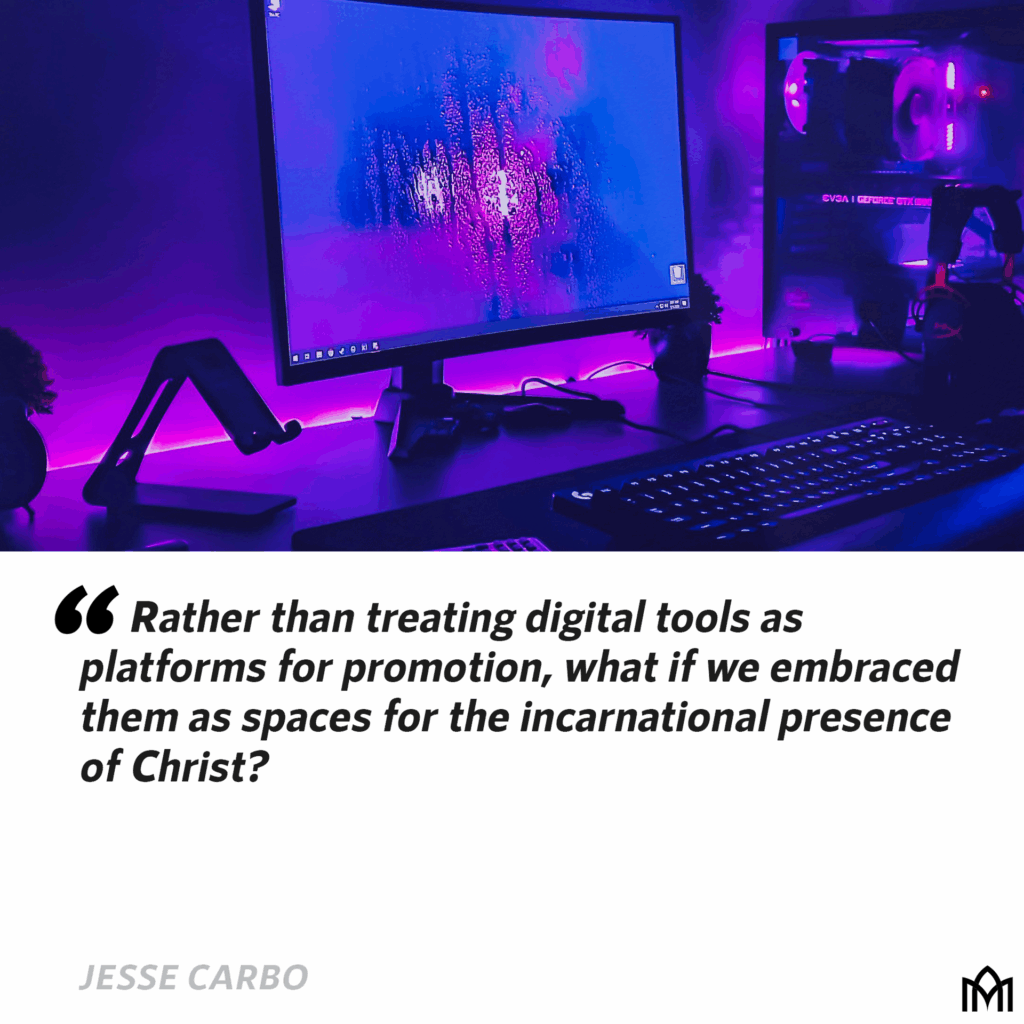Beyond Twitch: Incarnational Ministry in Everyday Digital Spaces
Why Your Church’s Instagram DMs Matter More Than You Think
In many church circles, digital ministry still carries a stigma. It’s viewed as a stopgap, a pale imitation of “real church,” or an impersonal marketing tool. But what if digital ministry isn’t second-rate—it’s just being mis-imagined?
Rather than treating digital tools as platforms for promotion, what if we embraced them as spaces for the incarnational presence of Christ? Not simply speaking at people, but dwelling with them. Comment threads, inboxes, and livestream chats can be more than content channels—they can be neighborhoods where the Church lives out the gospel.
When used relationally, digital tools can reflect Christ’s incarnational mission—marked by proximity, presence, and love. The opportunity isn’t only about expanding our reach; it’s about extending our presence. As with any mission field, we’re called to go where people are to embody the gospel there. And today, many people live online. I love what my friend Jeff Reed at TheChurch.Digital thinks about this reality: “The gospel has no barriers, and neither does this movement.”
The Digital Neighborhood Is Real
Missional leaders like Alan Hirsch and Jeff Vanderstelt emphasize two ideas central to the incarnational mission of Jesus:
- Go where people are, and
- Stay long enough to earn trust.
This model applies as much to digital culture as to physical communities.
The digital neighborhood can also be seen as real and necessary through the Great Commission work happening today in the Middle East, as one of the fastest-growing movements of the Gospel is with Muslims, largely living in the 10/40 Window. Mike Patino, CEO of Catalytic Ministries, writes the following:
“Because of the work Global Catalytic Ministries [GcM] does in the Middle East and the 10/40 window, it has forced us to bring a new level of apostolic creativity for the sake of the gospel and the security of our families in the field. While we always make disciples face-to-face, digital technology has become an integral part for sharing the Gospel as we coach believers in how to reach the lost all around the world.
Hudson Taylor said the Gospel moves through three things: access, people, and resources. Missing either one of these can potentially slow down movement. Today we have more access to people than ever before and we no longer need to labor for years to gain it. This can be compared to how Paul used Roman Infrastructure to spread the gospel. He would’ve used these tools in a heartbeat.
Digital storytelling is a vital part of our strategy, because it helps share Jesus even under the nose of Islam. It doesn’t replace incarnational ministry, it strengthens it.” (Mike Patino, CEO, catalyticministries.com)
If “the Word became flesh and moved into the neighborhood” (John 1:14, MSG), then we too must “move in”—not as tourists dropping content, but as residents building trust. People don’t just visit digital platforms; they live there. They grieve on Facebook, ask deep questions on Reddit, and seek connection on Discord. If mission means “being present where people live,” then ignoring digital spaces isn’t an option.
The church must stop treating digital space like a megaphone for announcements—or worse, a minefield to avoid. It’s neither. It’s a mission field to embrace.
When I was church planting in Orlando, FL in 2008, I learned about a concept called third places. These were coffee shops, parks, or anywhere one’s community naturally gathered. It was an important part of my church planting journey because I started to frequent the local Starbucks as my third place, and it was there that I met many of the people who ultimately joined our church family. Recently, people have begun to imagine the concept of digital fourth spaces. I love the definition of a digital fourth space that Jay Kranda develops in his article, “What is your 4th Space?:
“4th Spaces are a digital space where people gather, create, and connect, unrestricted by geography or time zones” (Jay Kranda).
People don’t just visit digital platforms; they live there. They grieve on Facebook, ask deep questions on Reddit, and seek connection on Discord. Ignoring digital spaces isn’t an option. Share on X
What Would Jesus Post?
Incarnational ministry is not about broadcasting—it’s about presence. Jesus didn’t shout from heaven. He entered our world, took on our flesh, and lived among us. Likewise, digital incarnational mission isn’t about going viral or building personal platforms. It’s about being available, relational, and consistent. Most churches aren’t planting Digital only churches on Twitch—but all churches are online.
Leslie Newbigin is a father of modern missional theology. He viewed the Church as existing to participate in the Missio Dei (mission of God) in every culture, which is the idea that mission is not simply an activity of the church, but part of its very essence and DNA. Notably, Newbigin and his contemporaries, such as renowned South African missiologist David Bosch, emphasized the “incarnational dimension” of mission. This meant that the gospel is not a static message sent from afar, but must be embodied in a people and its culture. They spoke of an ‘ongoing incarnation’ in which the Church is ‘born anew in each new context and culture,‘ rather than just replicating a single model. This insight has powerful implications for digital ministry. If the 21st-century digital realm is a ‘new context,’ then faithful mission will require the church to incarnate anew the gospel within digital culture – effectively to translate the unchanging gospel into the language, symbols, and practices of online life.
This kind of ministry isn’t flashy. It’s slow. It’s faithful. And it’s transformational.
Digital incarnational mission isn’t about going viral or building personal platforms. It’s about being available, relational, and consistent. Share on X
Four Practices for Incarnational Digital Mission
Here are four ways church leaders can reframe their digital ministry:
- Show Up in the Digital Neighborhood: Be present in real digital communities. Don’t just promote—participate. Be known. Be kind. Be consistent. People matter. Invest time where real discipleship can form—through comments, DMs, and digital relationships.
- Build Rhythms, Not Just Campaigns: Avoid one-off bursts of activity. Instead, develop rhythms of response and connection. Think long-term.
- Speak the Gospel in Local Digital “Languages:” Understand the context of each platform. Tailor your message in creative, accessible ways without compromising truth.
- Empower the Whole Church: Don’t centralize all mission through church accounts. Equip believers to see their digital lives—feeds, inboxes, comment sections—as their own mission fields.
Answering Common Critiques of Digital Mission
- “Incarnation Requires Flesh:” True—but we carry the Spirit of Christ. We follow His pattern. We show up. We stay. And yes, that can happen through a screen.
- “Digital Ministry Is Shallow:” It can be—but so can in-person ministry. Presence over performance makes the difference.
- “You Can’t Make Disciples Online:” Content alone doesn’t disciple. But digital spaces create connection points where real relationships—and real discipleship—can begin.
- “It Burns Leaders Out:” Only if you try to be everywhere. Be present somewhere consistently, not everywhere occasionally.
What Does Incarnational Presence Look Like Digitally?
- Responding to comments with care, not just blasting your message and leaving.
- Following up on prayer requests in DMs.
- Regularly showing up in the same online spaces—Facebook groups, Discord servers, YouTube chats—as a trusted voice.
- Asking more questions than we make statements—listening over speaking.
Viral Isn’t the Goal—Mission Is
Incarnational mission is the heartbeat of Jesus—and the calling of His Church. In a digital world, we have an unprecedented opportunity to live out that mission in new ways. This isn’t about clever content or catchy trends. It’s about being faithfully present, relationally consistent, and lovingly rooted in the everyday lives of real people online. Jesus said, “As the Father has sent me, so I am sending you” (John 20:21). That commission extends into every corner of culture—including the digital one.
Let’s stop treating online spaces like an afterthought. Let’s stop outsourcing presence to platforms, because the Church should aim to go viral–it must move incarnationally into the neighborhood, as Jesus once did, and now does through you.
///
When used relationally, digital tools can reflect Christ’s incarnational mission—marked by proximity, presence, and love. The opportunity isn’t just about expanding our reach; it’s about extending our presence. Share on X




